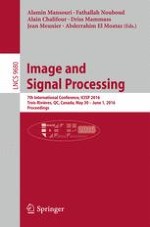2016 | Buch
Image and Signal Processing
7th International Conference, ICISP 2016, Trois-Rivières, QC, Canada, May 30 - June 1, 2016, Proceedings
herausgegeben von: Alamin Mansouri, Fathallah Nouboud, Alain Chalifour, Driss Mammass, Jean Meunier, Abderrahim Elmoataz
Verlag: Springer International Publishing
Buchreihe : Lecture Notes in Computer Science
